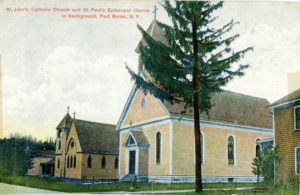Being the husband of a good and true Episcopalian, I have always had a soft spot for St. Paul’s Episcopal Church of Port Byron. The church was long gone before I ever came to town, but the few photos of it show a very attractive, yet small Victorian Shingle style building . It was located next to St. John’s Catholic Church on Rochester Street.
The history of St. Paul’s is almost as difficult to trace as are families who worshiped there. I am sure that if we had newspapers from the late 1800’s, this job might be a bit easier, but here is what I have found. In the 1851 minutes of the Episcopal Church, I found a mention of the Port Byron congregation of 1851 meeting in the Temperance Hall. However, as history is full of contradictions, an article in the 1952 Cayuga Chief noted that St. Paul’s was organized in 1863 with the Rev. J.A. Rowling in charge. I only found one listing for the Rev. Rowling living in Arcadia, Wayne County in 1860. In April of 1871, the Episcopalian congregation of Port Byron reorganized the church of St. Paul’s as the Church of St. Paul’s. This must have been a business matter to bring new life into the former church, who as I noted, did not have a church building to call their own. In fact, the Syracuse paper noted that the church even had land onto which to build an edifice. The officers of the church were made up of physicians, dentists, businessmen, and a lawyer. John Rice was a 76 year old physician, Rush Merrick Howard was a dentist, and the brother of the proprietor of the Howard House hotel, Steward Kendrick was a retired grocer, Alpheus H Crosby was also a physician. Later in 1871, the Rev. Robert Paul of Rhode Island, had been given charge of the Episcopal churches of Port Byron and Weedsport. In December of 1878, the Rev Bishop Huntington consecrated St. Paul’s Church of Port Byron. However, the construction of the building did not occur until November 1890, when the Bishop helped to lay the cornerstone of the new St. Paul’s.

Finding worshipers in Port Byron must have been difficult for the small band of merry Episcopalian’s. Around Christmas of 1897, it was announced that Bishop Huntington had discontinued services at both St Paul’s of Port Byron and St. John’s of Weedsport, mostly due to the lack of money to support them. Amazingly, this was not the end of the church, as the newspaper continued to carry articles about St. Paul’s. In July 1910, it was noted that regular services were being held at St. Paul’s under the care of the Rev. Mr. Houser, and that year’s Christmas service brought seventy-five worshipers to the church. In 1911, it was reported by the newspaper that the young paster Lewis E Ward of Auburn was the minister, although the publication “The Living Church” noted that Rev Guy P Burleson had entered the rectorship of St. John’s of Auburn and St. Paul’s of Port Byron in 1911. Later between 1925 and 1929, the Right Reverend Walter Higley served as a young clergyman. Later, the Reverend Higley would go onto become the Bishop for the Diocese of Central New York.
No one seems to know for certain when the church finally closed it’s doors for good, although it was likely in the 1930’s. Perhaps the Great Depression finally did it in. The building continued to stand for a number of years, as I have seen it in photos taken in 1947. But the story doesn’t end there. In the history of the Christ Church of Jordan, it is noted that members of that church learned that the Village of Port Byron had saved St. Paul’s bell, which had been gifted in memory of the John Dunhon family. The Jordan church asked if they might have the bell, as it had been sitting in storage in the Village garage for fifty-seven years. It was agreed and the bell was gifted to Christ Church. I have to wonder if it is still there.

